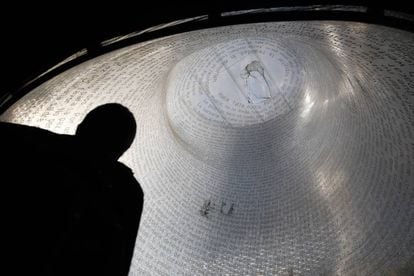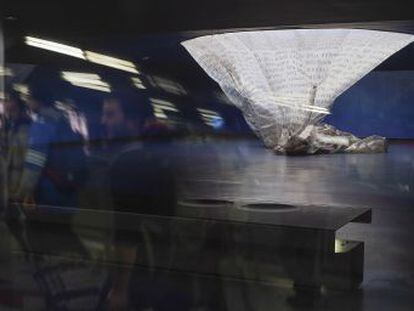Thirteen years after deadly Madrid train bombings, memorial in disrepair
City mayor had promised to fix it 18 months ago, but no progress has been made so far

Thirteen years after the Madrid train bombings that killed 193 people and left around 1,700 injured, the monument to their memory at Atocha station remains in a state of disrepair nearly a year and a half after it started falling apart.

The translucent membrane that makes up the core of this memorial at the Spanish capital’s largest train station is torn in three places, and patched up with pieces of plastic.
Rising to a height of 11.3 meters and shaped like a cylinder, the memorial is engraved with messages of condolence to the victims. The monument was praised at the time of its creation for its innovative design and pioneering materials, including the ethylene tetrafluoroethylene used in the membrane.
People complain that it is broken, and sometimes they ask if it’s going to get fixed
Atocha station employee
Although the memorial is inside a station that is the property of Adif, the state-owned railway infrastructure manager, responsibility for its maintenance falls to the city of Madrid. In November 2015, when EL PAÍS reported on its state of disrepair, Mayor Manuela Carmena pledged to fix it “as soon as possible.”
But on a recent visit, the three tears were perfectly visible: one at the top, and two others near each other, on one of the sides.
On any given day, the memorial attracts 800 to 900 visitors who come during regular opening hours (11am to 2pm and 5pm to 7pm). On anniversaries, this schedule is extended to 9am through 7pm. Some visitors spend just a few minutes inside the luminous space, while others stare at the dome for long stretches of time, say station employees.
Free men in 2017
Thirteen years after the Madrid train bombings, only 10 of the 18 people who went to prison are still behind bars. And by the end of 2017, two more will be released. The last convicts to walk free will be Spanish miner Suárez Trashorras, who provided the explosives, and the two men considered the perpetrators of the attack, Zougam and El Ganaoui. All three will remain in prison until 2044. There were originally 116 people under court investigation, of whom 28 were eventually placed on trial. Of these 21 were convicted of crimes by the Audiencia Nacional, the central high court, but the Supreme Court later reduced this number to 18.
“People complain that it is broken, and sometimes they ask if it’s going to get fixed. But we can’t answer them, because we don’t know anything about it,” said one employee who declined to provide his name.
This year’s municipal budget includes a €300,000 appropriation to reform the Atocha memorial, according to a spokeswoman for the Madrid culture department. Last year, €20,000 was earmarked for repairs.
There are plans to replace the system that currently keeps the membrane erect by pushing it up with columns of hot air. Besides being expensive, the heat has deteriorated the fabric. A new membrane is expected to go up, and this time it will be held up by cables attached to columns.
Since the municipal budget was recently passed, the work could begin by the end of the summer, once the reform contract has been awarded.
Following the Islamist attack of March 11, 2004 against commuter trains in the central station of Atocha, the city of Madrid and Renfe, the railway operator, organized a competition to create a memorial to the victims of Spain’s worst terrorist attack.
English version by Susana Urra.












































